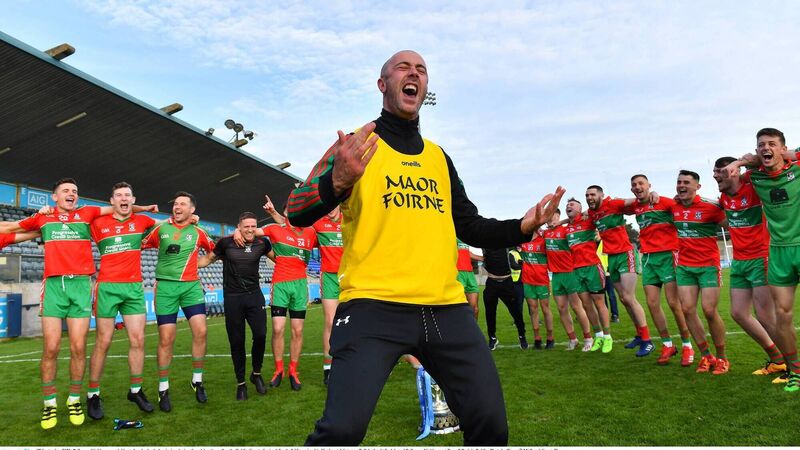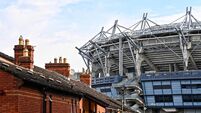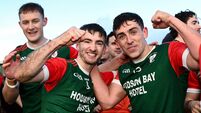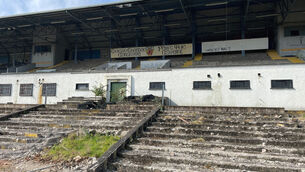Paul Rouse: Striking the right note - Why songs are an integral part of GAA culture

FINDING THEIR VOICE: Ballymun Kickhams coach Simon Lawlor leads the singing as they celebrate their Dublin SFC final win over Ballyboden St Enda’s last September. County songs played after matches in Croke Park are not about sport and, indeed, do not even reference sport. Instead, they relate to place.
There’s a thing that happens in Croke Park on big-match day that stirs the emotions like nothing else.
After the full-time whistle, the way a song associated with a particular county fills the air from the tannoy system brings together music and sport in a transcendent way.
And, when it comes down to the raw basics, the playing of that song means victory.
The song doesn’t necessarily have to be a great one – or even a good one – but if it connects a sporting success with people and place, it invariably moves at least some people to tears.
This connection between music and sport works on different levels.
In a 2014 article published in the academic journal, Sport in Society, Professor John Nauright – an American academic – noted how major sporting events and almost every professional sporting team now used some sort of music as an official theme song.
He also showed how various popular music songs – and not necessarily famous ones – were “expropriated by sports fans as a way of expressing their collective identities.”
The most obvious example of this is the manner in which ‘You’ll Never Walk Alone’ became so central to the identity of Liverpool FC.
It is true that this is a song that was sung by other supporters at different times – for example, it was sung by Chelsea fans at matches in Stamford Bridge in the 1970s – but it is in Liverpool that it found its enduring and essential connection.
It is even the case that certain styles of music become utterly bound up with the identity of certain sports. This is evident in the relationship between hip-hop music and basketball, or between Caribbean cricket and calypso music.
Nauright also looked at something different, however; something that he said was much less common – the inclusion of references specific to certain sports within the lyrics of popular music songs.
There are obvious exceptions: In Bruce Springsteen’s great song ‘Glory Days’, the first verse is rooted in the nostalgia of a schoolfriend who had been “a big baseball player.”
In his article, Nauright focussed on the Tuam band, The Saw Doctors, because he wrote “sport, particularly Gaelic football, forms a recurring theme that appears in many of their songs, and their lyrics focus on place as central to identity.”
Indeed, so central is Gaelic football to the music of one of the main men in The Saw Doctors – Leo Moran – that he even temporarily established a secondary group called ‘The Folk Footballers’ with Padraig Stevens.
In one of their football songs, ‘Maroon and White Forever’, The Folk Footballers dream of winning for the county:
More than that, the music is reverential to local legendary footballers, Frank Stockwell and Seán Purcell. That Moran’s father had played on the same team as these ‘terrible twins’ added further depth to the song written in their honour, with Purcell claimed as the greatest Gaelic footballer of all time.
There are more than a dozen Saw Doctors songs that include Gaelic football (and others which nod to hurling).
This elevation of football is related – of course – to the fact that Tuam is footballing country and the Tuam Stars are a celebrated, historic team.
As Professor Mike Cronin of Boston College has noted, The Saw Doctors’ songs about Gaelic football “are deeply rooted in shared local traditions, parochial loyalties and personal memories.”
But as Cronin has also noted, the localism of The Saw Doctors is not parochial and their music is also rooted in the manner in which the culture of their home time – and of the people who emigrated from that town – was changed and affected by various forms of globalisation.
What is once again abundantly clear in all of this is just how different life in a small town in Ireland is from the limitations of the cliches which are normally applied; the music of The Saw Doctors makes this apparent at every turn.
And, what is also hard to escape is that there are few enough towns in Ireland where you could record an authentic rendering of life without reference to football or hurling.
As Cronin notes, the county songs played after matches in Croke Park are not about sport and, indeed, do not even reference sport. Instead, they relate to place and are almost always traditional or sung too traditional airs.
The songs often celebrate the geography and topography (‘Slievenamon and ‘The Banks’), people (‘The Rose of Tralee’) and traditions (‘Molly Malone’) of a county, often also appealing to those who are in exile but who can conjure up the imagery of home.
Almost always, the history of a county – its folklore and traditions – are a constant point of reference. The most modern of successes are played out (and appraised) against the backdrop of the past.
While, of course, no song in either lyrics or melody could be expected to match the beauty of The Offaly Rover (with its heather-scented air, its calls to pile the turf high beside the fire, and to bring the keg in from barn), there is something about The Saw Doctors singing the ‘Green and Red of Mayo’ that is a little different.
And after the final whistle on Sunday, if Mayo win – unlikely as it may be and of course also because it is just so unlikely – the sound of a Galway band (a band that sang ‘The Maroon and White Forever’!) is the only thing Mayo people all over the world wish to hear. It would be the musical herald of a new age.
And yes, the moment would be stripped of the image of tears shed in a stadium, but it would bind together people in music and sport, through lyrics that celebrate a shared identity and a love of place:











